David's Astronomy Pages
|
Notes (S198) |
Notes (Main) |
Home Page |
Notes (S208) |
|
Observed Problem
As part of a project preparing to record an exosolar planet transit of HAT-P-2b, a series of baseline images of HAT-P-2 were acquired over the past 3 sessions (S196-198) . Whilst the star is clearly very suitable for recording a future transit (it is well positioned in the sky for observation, it is is reasonably bright giving a high S/N for short expsosures and has suitable reference stars within the same field of view) , baseline work showed that calculated flux from HAT-2-P was varying slightly with time and took small jumps between different image sets/sessions, rather than giving consistent values. The difference are small, but they are significant considering the ultimate aim of spotting 1% dips in the light flux during planet transits.
|
HAT-P-2 - Comparison between datasets on 2007-05-07 and 2007-05-15 |
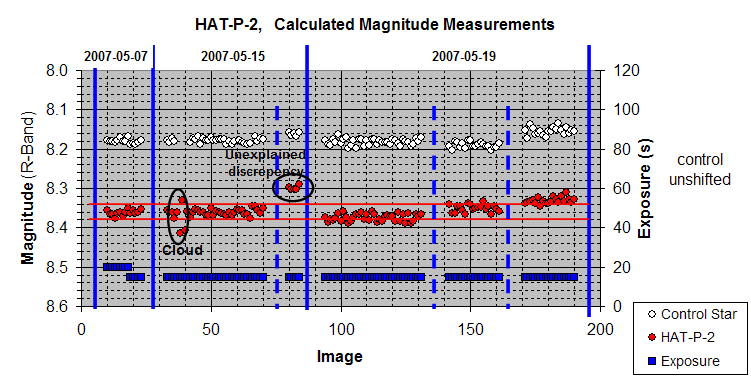 |
Description of earlier baseline series of 2007-05-07 / 2007-05-14 / 2007-05-19
Analysis of the Problem
The problem was examined and it was noticed that the target and reference stars where not being held on consistent CCD pixel positions but drifted in Declination with time, which then showed up any small (but significant) deficiencies in the flat fields used for image reduction. There are two underlying causes to the problem
- imprecise polar alignment
- difficulty in achieving perfect flat fields
Whilst flux measurement and calibration would
undoubtedly be helped by using improved flat fields, a particular limitation of
my equipment is that the SBIG ST7e camera (0.9 kg) is too heavy to be held
steady by my JMI NFG-S focusser causing the CCD camera to sag in a way that that
leads to the position of optical axis centre and thus the vignetting pattern to
vary as the scope points to different parts of the sky. This results
in differences between the vignetting experienced by flat frames and the light
frames of the target star. This problem could be expected to also lead to
differences in the vignetting experienced as the scope tracks a target star for
the potential 3 or 4 hour period during a transit observation. The same
problem also prevents achievement of a reliable collimination of the
scope. It is uncertain what I can really do to improve the stability
of my CCD camera, short of buying a lighter CCD camera or a different /more
robust focuser.
Polar Alignment was last reset in December 2004 , and up to now hasn't really
presented itself as a significant problem, for taking images up to 2-3 mins
duration. However it is known that Polar Alignment is off by some 40 arc
secs.
Tracking Analysis
Images from a 14 minute long unguided observing run of HAT-P-2 were examined, and positional data is plotted below.
| Measurement & Analysis of Tracking (no guiding) |
The graph shows that the average declination drift over the observing runs was 1.16 arc sec/min. This figure is similar to a drift rate of 1.25 arc sec/min measured directly after Polar Alignment Settings in Dec 2004 and suggests there hasn't been any major change or deterioration in Polar Alignment over the past 3 years. However the challenging demands of exosolar planet detection suggest benefits could be achieved by improving Polar Alignment.
The graph above shows variation in X position caused by residual periodic error. This error is further illustrated in the graph below. The data is wrapped after 8 minutes, and the second line shows the RA variation is being repeated. The total periodic error of my LX200 mount is +/-25 arc secs, but Periodic Error Correction (PEC) training in Dec 2007 reduced this to around +/-2 arc secs. The new graph shows that residual periodic error is still holding at a figure of around +/- 2 - 3 arc secs. The challenging demands of exosolar planet detection suggest that some additional benefits could be achieved by further refining PEC.
| Periodic error |
Improvement Plan
One way of reducing the impact of this flat field difficulty is to try to ensure the target star and reference stars remain at constant x/y pixels positions for the duration of an observing run, and then rely on photometric calibration to provide good measurements of light flux from the target star.
Options to keep stars stationary on the CCD are
considered to be as follows:
- improvements to polar alignment to reduce star drift
- improvements to PEC/ periodic error correction to reduce jitter in RA position
- autoguiding continuously using self guider chip looking at adjacent star
- autoguiding between frames
A future session will be used to improve polar alignment, improve PEC and build a new TPoint Model. Although this will lose a night of observing/variable star monitoring it will should ultimately give advantages beyond just the task of exosolar planet detection.
Autoguiding continuously using the self guider chip suffers the difficulty of being able to consistently find or position a star of sufficient brightness on the guider chip, whilst meeting the requirement of having the target and references stars centrally positioned on the main imager which already has itself a small field of view. In the past it has proven difficult to maintain position when thin cloud occasionally blocks out the guide star, and causes the guide star to be lost.
As a potential fix to tracking issues, a software routine was written to correct scope position between frames. This routine was tested during S199 session.
Back to Top
Results of guiding between 15s exposure frames over two 15 minute observing runs are shown in graphs below. The second run is the best (star held to just +/-1 pixel) and shows that most of the declination drift has been corrected by guiding. The impact of period error remains however.
| Guiding Results - Run 1 |
| Guiding Results - Run 2 |
Back to Top
A further series of baseline images of HAT-P-2 (host star
to exosolar planet HAT-P-2b) were acquired through R filters, at the same time
as conducting tracking and guiding tests.
(Description of earlier baseline series of
2007-05-07 / 2007-05-14 / 2007-05-19
)
Set of
R Band images were acquired with 15s
exposure at airmass values of 1.12, 1.08 and 1.04. Average S/N value for
HAT-P-2 was 212, 213 & 217 (compared to
average of 217 measured on 2007-05-07, and average value of 212 on 2007-05-14).
The calculated R Band magnitude for HAT-P-2 was 8.37 +/-0.01 from an initial 15 minute run. This is very similar to value of 8.36 +/-0.01 calculated for a 15 minute run on 2007-05-14, 8.36 +/- 0.01 calculated for a run on 2007-05-07. (these values can be compared with an expected R Band magnitude of 8.47, based on Arne Equations & catalog Bt, Vt values). A second and third run produced a calculated magnitude of 8.35 +/- 0.01 and 8.33 +/- 0.01. These show up a small drift in calculated magnitude associated with errors caused by weaknesses in the flat field reduction.
Plotting the difference between calculated HAT-P-2 magnitude of individual images and average HAT-P-2 magnitude in shows a range from -0.015 to +0.016 (or a SD of 0.007).
| HAT-P-2, Reference Stars |
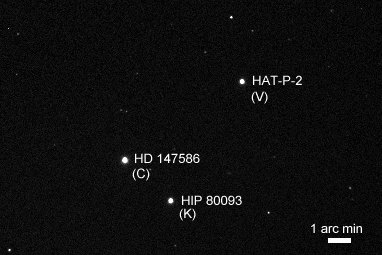 |
| Annotated CCD Image 20s, 2x2 binning, R Filter 2007-05-07 23:31 hUT (#196065) |
| Analysis of HAT-P-2 Base Line Images (R Band) |
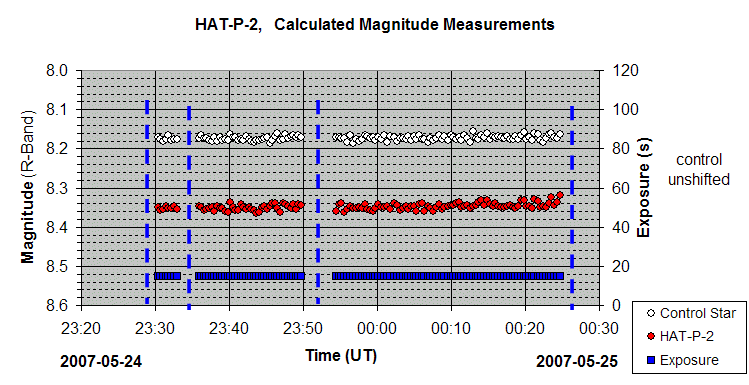 |
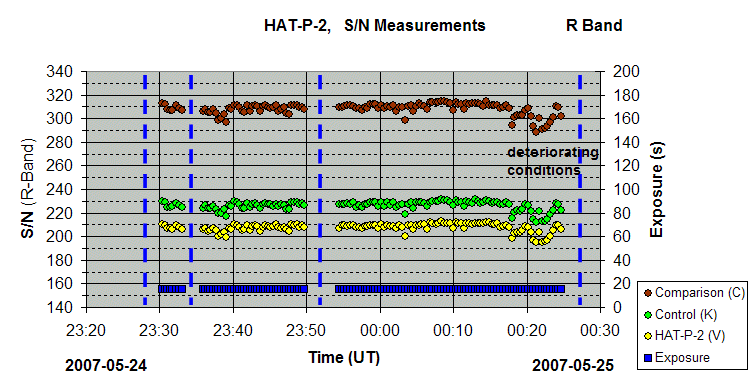 |
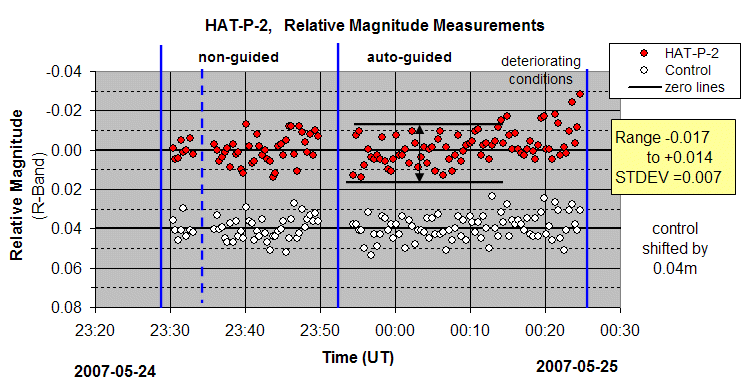 |
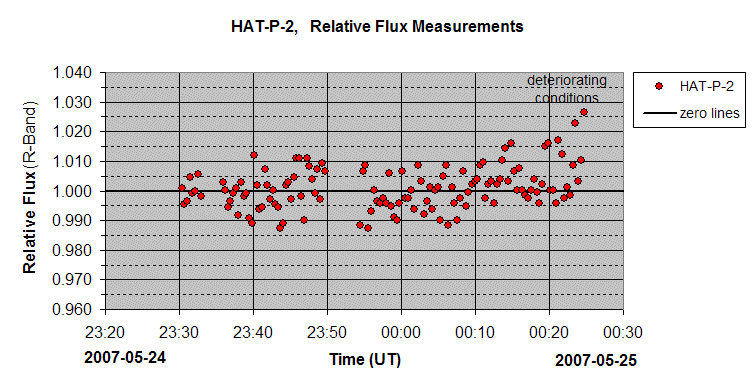 |
|
HAT-P-2 - Comparison between datasets on 2007-05-07 and 2007-05-24 |
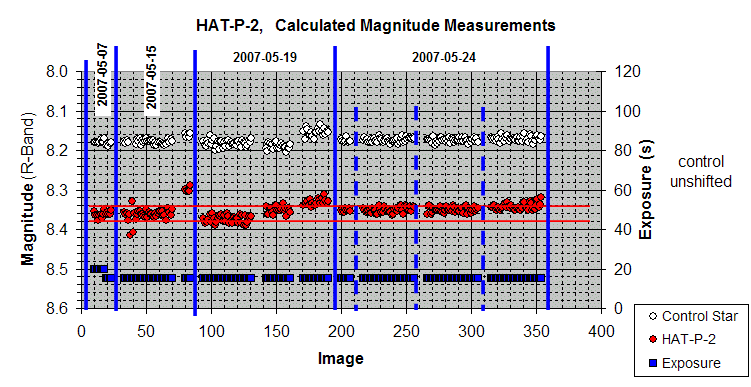 |
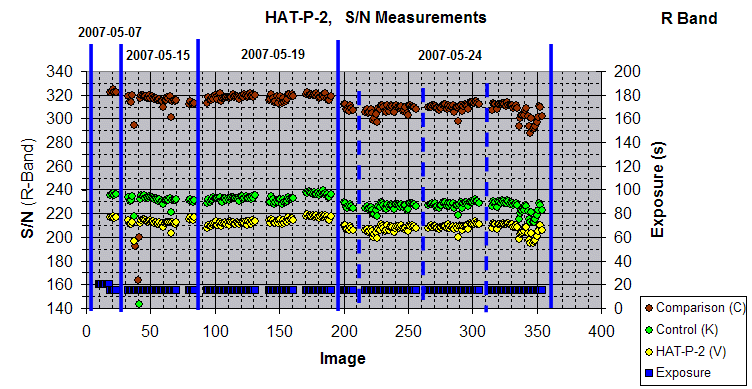 |
Back to Top
A series of images of the near earth passing minor planet MPL 2006 VV2 were taken on 2007-04-01. Stacked image and animated sequence of images are shown below. It was noted at the time that the minor planet's path appeared to wobble, yet it was clearly evident that this could not have been an actual wobble or rotation in the minor planet. Although relatively close to Earth, the minor planet is still much too far distant for any wobble/rotation to be observed.
|
MPL 2006 VV2 (passing through star field in Leo Minor) |
|
|
|
CCD Image 15 x 30s exposure (average combine), 2x2 binning, C filter, 2007-04-01 20:19 to :20:28h UT (#187050-64) |
|
|
|
CCD Animation showing motion of MPL 2006 VV2 |
|
|
|
Animated CCD Image Frames 26 x 30s exposures with 6 sec gaps, 2x2 binning, C filter, 2007-04-01 20:31 to :20:46h UT (#187068-93) |
| Goto images of MPL 2006 VV2 (Session S187) |
Although the possibility of a periodic error effect was considered the true cause of the wobble effect remained a bit of a mystery until it was decided to make a simulated picture of minor planet's apparent path assuming a residual periodic error of +/-2.5 arc secs for the LX200 scope. There is a very similar pattern of wobble between the simulation and actual images, proving beyond reasonable doubt that the observed wobble was due to residual periodic error in the scope's tracking.
| MPL 2006 VV2 simulated track
assuming a periodic error of +/-2.5 arc secs |
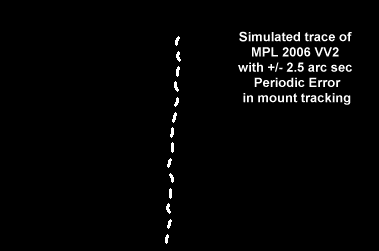 |
Back to Top
| This Web Page: | Notes - Session 199 (2007-05-24) |
| Last Updated : | 2015-05-16 |
| Site Owner : | David Richards |
| Home Page : | David's Astronomy Web Site |